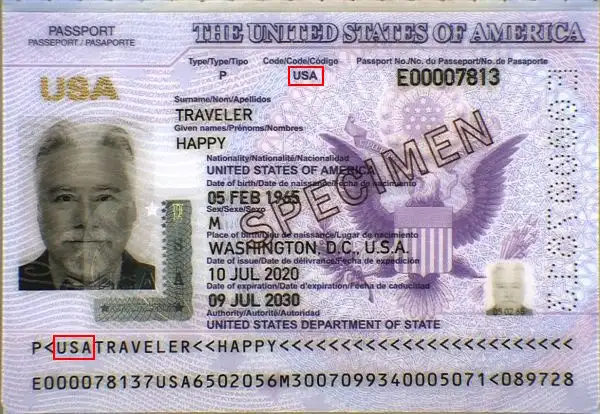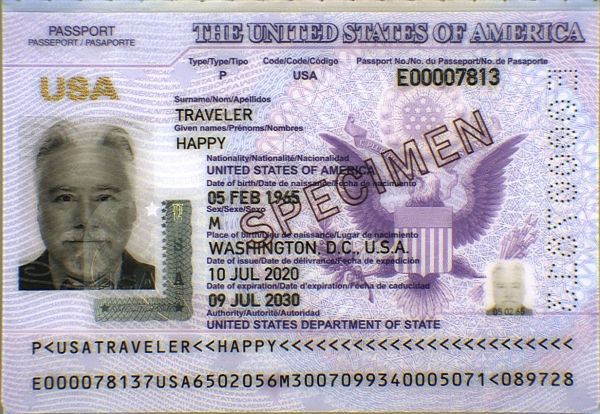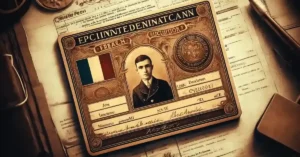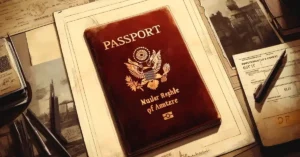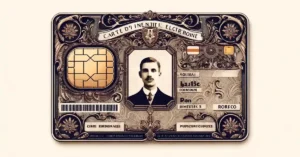Verifying a person’s identity is necessary across many sectors to prevent fraud and impersonation.
Passports are widely used documents in this context and contain several security features: so how can you verify a US passport online and ensure that the presented document is authentic? The answer is in this article!
Need more information on how to verify the authenticity of your ID documents ? Check out our comprehensive guide to verifying ID documents, which includes all the resources available !
Check 1: General Appearance to Verify a US Passport Online
The first step to verify a US passport online when you have access to the original document is to check its overall appearance: it must show no signs of cutting, peeling, modification, or correction.
Pay close attention especially to the photo area and its surroundings.
Check 2: Read, Cross-Check, and Verify Numbers and Information on US Passports
The second step to verify a US passport online is to ensure the consistency of the information present on the document.
Document Number
The document number can be found in two different places: at the top right on the front and at the beginning of the second line of the MRZ band.
Both must be identical:
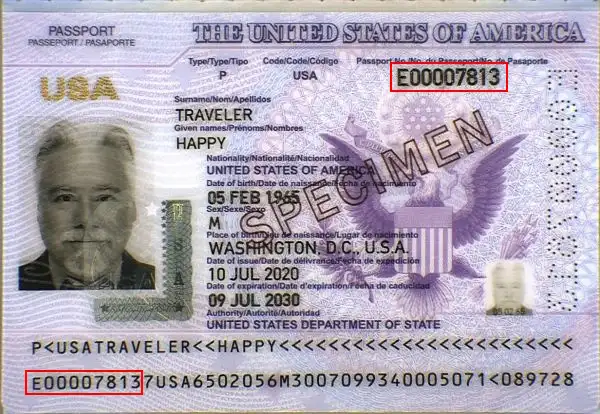
Date of Birth
The date of birth of the holder can also be found in two distinct places: in the middle of the front and in the middle of the second MRZ line in the format YYMMDD:

Name and Given Name(s)
Similarly for the last name and given names, which can be found on the document and in the first MRZ line:
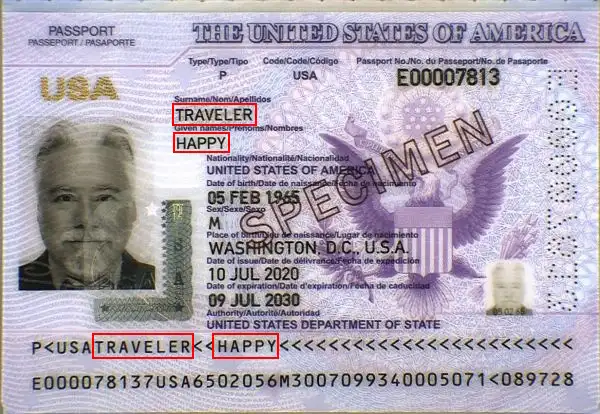
Holder’s Gender
The holder’s gender is symbolized by “M” for males and “F” for females. This information can be found on the front and in the second MRZ line:
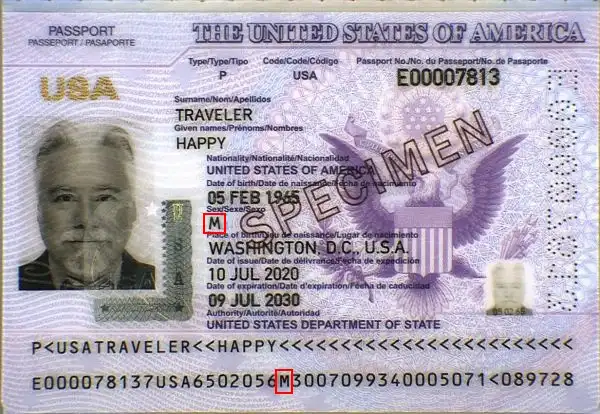
Document Expiration Date
Another element present twice on the document is the expiration date, which can be found on the front and in the second MRZ line in the format YYMMDD:
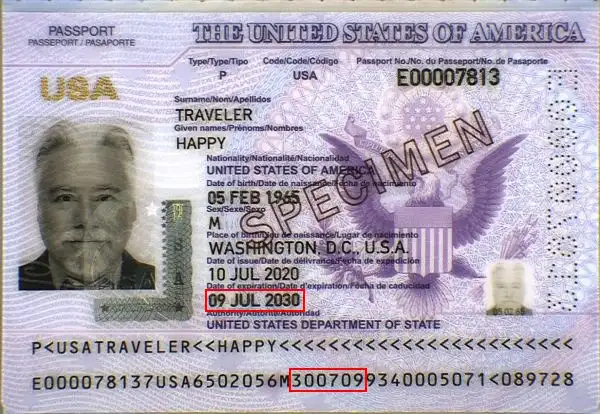
Issuing Country
The issuing country can be found in two places on the document: at the top of the front and at the beginning of the first MRZ line.
Nationality
The holder’s nationality can be found in the second MRZ line in ISO 3166-1 format:
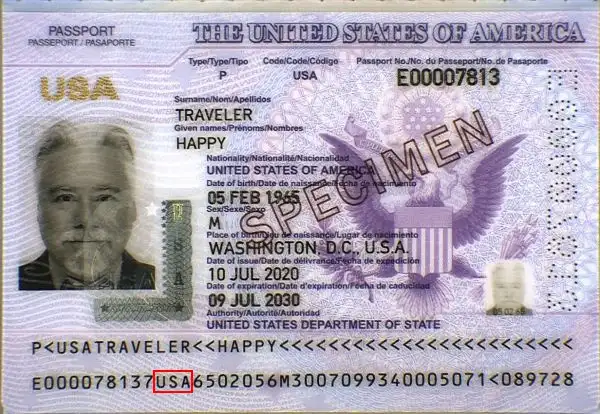
Check 3: Verify a US Passport with its MRZ Band
The lower part of the US passport consists of two lines that repeat the information on the document, with validation keys that prevent reading errors or forgery.
Composition of the US Passport MRZ Band
First Line

- Document Type: 2 characters, code indicating the type of document, represented by the letters “P<“.
- Issuing Country: 3 characters, the ISO 3166-1 alpha-3 code of the issuing country.
- Last Name(s): holder’s last name(s), separated by a chevron “<“.
- Given Name(s): holder’s given name(s), separated from the last name by two chevrons, and separated among themselves by a chevron “<“.
Second Line

- Document Number: 9 characters, the passport number printed on the document.
- Check Digit: 1 character, check digit for the document number.
- Nationality: 3 characters, nationality of the holder.
- Date of Birth: 6 digits, holder’s birth date in YYMMDD format.
- Check Digit: 1 character, check digit for the date of birth.
- Gender: 1 character, holder’s gender (“M” or “F”).
- Expiration Date: 6 digits, passport expiration date in YYMMDD format.
- Check Digit: 1 character, check digit for the concatenation of characters line 2 positions 44-54, line 2 positions 57-64, line 2 positions 65-87.
Verify a US Passport Using the MRZ Security Keys
A US passport contains 5 check digits (or security keys) that validate the preceding information.
They prevent transcription errors or intentional or unintentional modifications.
How Does the Algorithm Work?
The algorithm used to create and validate the check digits is common to all identity documents: characters have weights, which are multiplied by a factor depending on their position in the string (7, 3, and 1).
Digits have their face value (“0” equals 0, “1” equals 1, etc. up to “9” equals 9), the chevron “<” also has a value of 0, while letters are weighted starting at 10 for “A”, 11 for “B” up to 35 for “Z”.
Example
Let’s take as an example the check digit for the date of birth from the specimen above.
The string to validate is: “650205”.
To calculate the check digit, we proceed as follows:
– “6” has a value of 6 and is in the first position, so multiply by 7: 6 * 7 = 42
– “5” has a value of 5 and is in the second position, so multiply by 3: 5 * 3 = 15, add to previous 42 for a total of 57.
– “0” has a value of 0 and is in the third position, so multiply by 1: 0 * 1 = 0, add to previous 57 for a total of 57.
– 2 * 7 = 14 and 14 + 57 = 71
– 0 * 3 = 0 and 0 + 71 = 71
– 5 * 1 = 5 and 5 + 71 = 76
We get a total of 76, from which we extract modulo 10 (the remainder of the Euclidean division by 10), which keeps only the last digit, “6”.
Our check digit is therefore valid since 6 appears on the document!
Individuals, do you occasionally need to verify one or more identity documents ?
Professionals, do you need to integrate proof of identity validation into one of your business processes, including all European identity cards and global passports ?
Check 4: Security features to verify the authenticity of a US passport
An identity document has various features that help validate its authenticity.
This is the final and longest step to verify a US passport online: we will review the different security features present on the pages of the US passport.
Page 2 (front)
Oblique lighting
Ultraviolet
Optically Variable Ink (OVI/OVD)
This is an iridescent ink or holographic patch that changes color (green ↔ gold, for example) depending on the viewing angle. The microprism or thin layer structure is very difficult to copy; a fixed or dull shade indicates a counterfeit.
Ghost image in black and white
A miniature black & white version of the main portrait is printed or engraved in a corner of the page. If the main photo is replaced, the ghost will no longer match, revealing the alteration.
Photo, ultraviolet
Under UV light, the photo frame (and sometimes the portrait itself) shows hidden fluorescent patterns. Their shape and position are calibrated; lack of response or misalignment indicates fraud.
Printing process / microtexts
Identity pages use a combination of secure offset, intaglio, and microprinting (< 0.2 mm). Under magnification, letters must remain sharp; ink bleeding or pixelation reveal digital reproduction.
Conclusion
You now have all the keys to verify a US passport online and ensure it is authentic!
No need for specialized equipment: a bit of vigilance, time, and you can avoid most of the frauds that can be encountered daily!
You can also use our service which will perform the verifications in a few seconds via our web application: the results are available directly in the app and in PDF report format!
Individuals, do you occasionally need to verify one or more identity documents ?
Professionals, do you need to integrate proof of identity validation into one of your business processes, including all European identity cards and global passports ?

